#Asteriornis maastrichtensis
Text
Modern-type birds share several key traits, such as toothless beaks and fused foot bones. The almost 11,000 living bird species — the paleognaths (flightless birds such as ostriches), anseriformes (waterfowl), galliformes (land fowl) and neoaves (the remaining 95 percent of living bird species) — all share a common ancestor, Field says. “We think that ancestor lived at some time before the end of the Age of Dinosaurs,” he says. But there are very few bird fossils surviving from before the asteroid impact.
3 notes
·
View notes
Text
Round Two: Vorombe vs Asteriornis
Vorombe titan

Artwork by @otussketching, written by @zygodactylus
Name Meaning: Titan of the Big Birds
Time: 10,000 years ago to sometime in the past 2000 years (Holocene epoch of the Quaternary period)
Location: Southern Madagascar
Vorombe is a newly erected genus of Elephant Bird, the largest that we know of! Whereas all species of Elephant Bird used to be put in the same genus, distinct differences among the types of Elephant Bird that we know of indicate they deserve their own genus names - and here we are! Vorombe was significantly larger than the other species of Elephant Bird, and probably was about 3 meters (nearly 10 feet) tall when standing. It was also ridiculously heavy, weighing around 650 kilograms. As such, Vorombe is currently the largest known bird ever recorded. It lived in the arid and succulent woodlands as well as the grassland mosaics, the weirdly unique habitats that charactierize Madagascar, and was a major feature in the functioning of those ecosystem - helping to spread plant seeds and maintain habitats as they lived within them. Vorombe and other Elephant Birds lived alongside a lot of weird animals during the Quaternary of Madadgascar, including dwarf hippos, giant tortoises, and giant lemurs.
Note: A paper came out literally on the last day of February this year indicating Vorombe may not be its own genus. More work is needed to determine if this bird is distinct from Aepyornis.
Asteriornis maastrichtensis

Artwork by @otussketching, written by @zygodactylus
Name Meaning: Asteria’s Maastrichtian Bird
Time: 66.8 million years ago (Maastrichtian stage of the Late Cretaceous_
Location: Maastricht Formation, Eben-Emael, Belgium
Say hello to the Wonderchicken! While we know that modern dinosaurs - birds - had to have evolved in the Mesozoic, and diversified somewhat during it, actual fossil representatives of Mesozoic modern birds are quite rare, with only a few duck-related taxa (Vegavis and Teviornis) known. Asteriornis finally adds a stem-chicken to that group, which we knew had to have been around since we had stem-ducks! (They diverged at the same time, so the presence of stem-ducks requires the presence of stem-chickens). A small, long-legged bird, Asteriornis had a lot of characteristics similar to both chickens and ducks, indicating it may have evolved right after that initial divergence. It had a slightly down-curved beak without specializations, allowing it to have a generalist diet. It had wings similar to living ground birds, and that combined with its long legs indicates a terrestrial lifestyle. Living along the coast, Asteriornis would have eaten whatever it could forage for, possibly wading into the water or trekking through high vegetation when necessary. It lived near the ocean, along the coast, and as such it shared its habitat with many types of invertebrates, including corals and echinoderms and crustaceans, as well as ammonites. Surrounded by grasses, palms, and shrubs, Asteriornis also lived alongside other vertebrates such as a wide variety of sharks, tons of mosasaurs, turtles, elasmosaurs, marsupials, and other dinosaurs such as Orthomerus, Janavis, large theropods, an unknown opposite-bird, and other potential Ornithurans.
#dmm#dinosaur march madness#dinosaurs#birds#dmm rising stars#dmm round two#birblr#palaeoblr#paleontology#bracket#march madness#polls#vorombe#asteriornis
135 notes
·
View notes
Text
This is mostly just a reminder to myself if I (or anyone else if you get to it first) ever get around to drawing Rung in the Birdformers au.
He’s gonna be an asteriornis maastrichtensis, one of the oldest birds in the known fossil record.

Since the Birdformers au takes place in modern day, very, VERY few characters can be extinct birds, and even then it’ll be birds that went extinct within the last 160 years or so.
Rung is an enigma to everyone lol. He’s older than the human species, and no one knows how he’s lived for so long.
He probably doesn’t know himself, but he’s more keen on just vibing and providing any advice/helpful words and such.
#fun fact asteriornis maastrichtensis is nicknamed the wonder chicken and is the only known species in its group#which was also related to an extant group that contains chickens and ducks#text post#rung#birdformers au#asteriornis maastrichtensis
41 notes
·
View notes
Link
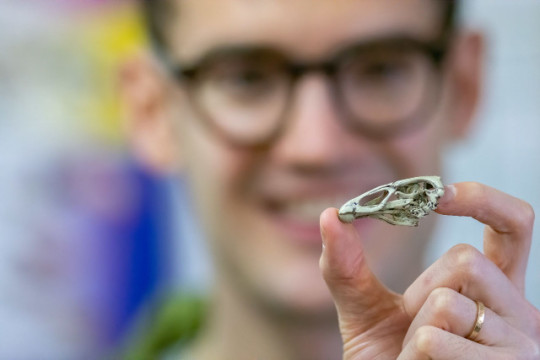
An article published in the journal "Nature" reports the identification of a new primitive bird that lived near the end of the Cretaceous period, almost 67 million years ago, near the border between today's Belgium and Holland. A team of researchers led by the University of Cambridge subjected the fossil bones of what was named Asteriornis maastrichtensis to a high resolution CT-scan to create 3D reconstructions. In particular, the skull is one of the best preserved among bird fossils. Its characteristics bring together those of modern chickens and ducks, suggesting that it's a species very close to their last common ancestor.
1 note
·
View note
Photo
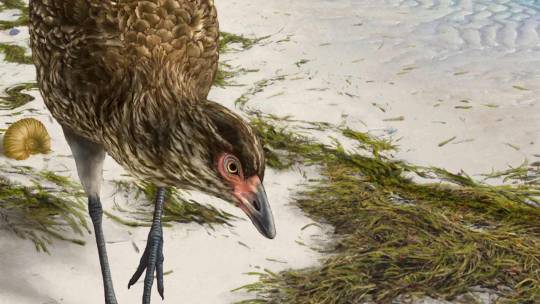
‘Wonderchicken’ fossil shows link between dinosaurs in their day and modern day birds- Technology News, Firstpost FP TrendingJul 20, 2020 16:31:24 IST A study has discovered the oldest fossil of a modern bird, dating all the way back to the age of the dinosaurs.
#age of dinosaurs#archeology#Asteriornis maastrichtensis#Cretaceous period#Paleontology#university of cambridge#wonderchicken#wonderchicken fossil#X-ray CT scans
0 notes
Photo
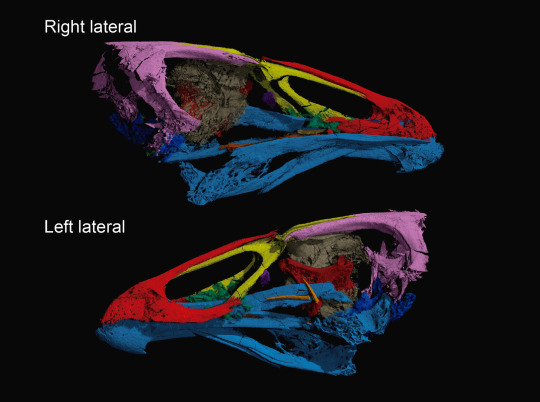
At last it can be told: meet the “Wonderchicken”! In 2018, my supervisor Daniel Field arranged a loan of a specimen from the Maastricht Natural History Museum in the Netherlands. We were interested in this block of rock because there was the fossil of an avian leg bone exposed on its surface... but after the rock was CT-scanned, we were surprised to see a nearly complete bird skull inside!
After detailed study, our team (consisting of Daniel, Juan Benito Moreno, myself, John Jagt, and Dan Ksepka) determined that this fossil most likely represents a close relative of the last common ancestor of ducks and chickens. We have affectionately nicknamed it the "Wonderchicken", but gave it the scientific name Asteriornis maastrichtensis, after Asteria, the goddess of falling stars in Greek mythology. Given that the fossil comes from near the end of the Late Cretaceous, Asteriornis is one of the oldest modern-type birds known.
Our paper has been published today in Nature here. I’ve also written about our findings in my blog post here.
883 notes
·
View notes
Text
The Top Ten Dinosaur Discoveries of 2020
https://sciencespies.com/nature/the-top-ten-dinosaur-discoveries-of-2020/
The Top Ten Dinosaur Discoveries of 2020

There’s never been a better time to be a dinosaur fan. Even in a year where fossil explorations have been curtailed because of the COVID-19 pandemic, paleontologists have dug deep to describe dozens of new species and unlock new secrets about our favorite prehistoric creatures. The discoveries continue even now, with the fluffy “maned” dinosaur Ubirajara named just last weekend. As we anticipate what the fossil record might reveal in 2021, here’s a look back at ten dinosaur discoveries that surprised and enthralled dinosaur enthusiasts this year.
Tiny Fuzzball Shows How Dinosaurs Started Small

Life restoration of Kongonaphon kely, a newly described reptile near the ancestry of dinosaurs and pterosaurs
(Illustration by Alex Boersma)
Some of the key traits that allowed dinosaurs to be such an evolutionary success story—from fuzzy feathers to warm-running metabolisms—may have first evolved in their tiny ancestors. This year experts reported the discovery of a tiny reptile from the Triassic of Madagascar they named Kongonaphon. While not a dinosaur itself, this animal was close to the ancestors of both dinosaurs and related flying reptiles called pterosaurs. This small, insect-eating reptile likely moved nimbly to catch lunch and may have sported a coat of fuzz to help regulate its body temperature. This hints that some key dinosaur traits, such as warm-bloodedness and insulating body coverings, evolved early in their history and were elaborated upon as dinosaurs eventually diversified into all sorts of shapes and sizes.
Winner By a Tail

Spinosaurus used its tail to swim
(Gustavo Monroy-Becerril CC BY-SA 4.0 )
Paleontologists have long suspected that the giant carnivore Spinosaurus spent much of its time around the water. Fossils reported in 2015 went a step further—flat feet and dense bones indicated that Spinosaurus spent a great deal of time in the water and is the first known semi-aquatic dinosaur. This year, a tail added another clue. The appendage, found at the same quarry as the 2015 skeleton, is long and deep. The tail is more like a paddle than what’s seen in other carnivorous dinosaurs and would have been suited to swishy, side-to-side motions that propelled Spinosaurus through the water. The fact that the tail goes with the other fossils found at the site also confirm that they all go to one individual, underscoring the fact that Spinosaurus had strange body proportions unlike any other dinosaur yet discovered.
Dinosaurs Suffered From Cancer, Too

A Centrosaurus skeleton in the mass dearth assemblage at the Royal Tyrrell Museum
(Riley Black)
Dinosaurs are often celebrated for being big, fierce and tough. The truth, however, is that they suffered from many of the same injuries and maladies that humans do. A study published this year in The Lancet reported on the first well-documented case of malignant bone cancer in a non-avian dinosaur. The animal, a horned dinosaur known to experts as Centrosaurus, probably coped with declining health before its eventual death in a coastal flood that caught its herd off-guard.
Dinosaurs Weren’t in Decline When the Asteroid Hit

A Tyrannosaurus rex holotype at the Carnegie Museum of Natural History
(ScottRobertAnselmo CC BY-SA 3.0)
If dinosaurs “ruled the Earth” for millions of years, why were they hit so hard by the mass extinction of 66 million years ago? Paleontologists have been puzzling over this question for decades, and, some have suggested, dinosaurs might have already been dying back by time the asteroid struck. But an increasing amount of evidence contracts that view, including a study published this year in Royal Society Open Science. The researchers looked at different evolutionary trees for what dinosaurs were around during the end of the Cretaceous to track whether dinosaurs were dying out, thriving or staying the same. After sifting through the data, the paleontologists didn’t find any sign that dinosaurs were declining before the asteroid strike. In fact, dinosaurs seemed perfectly capable of evolving new species. If the asteroid had missed, the Age of Dinosaurs would have continued for a very long time.
Taking a Long Swim
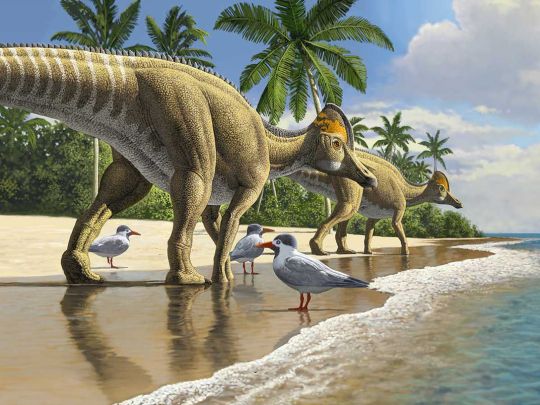
Researchers found the remains of a duckbilled dinosaur in Morocco.
(Raul Martin)
Sometimes dinosaurs show up where we don’t expect them. While paleontologists have found numerous fossils of duckbilled dinosaurs at spots around the world—from North America to Antarctica—no one had ever found one in Africa. That changed this year. In a Cretaceous Research study, paleontologists described a new species of hadrosaur found in Morocco. Named Ajnabia, the dinosaur lived at the end of the Cretaceous during a time when Africa was separated from other continents by deep water channels. Swimming would have been the only way for the dinosaur to reach prehistoric Africa from Europe or Asia, reinforcing the idea that exceptional events can help species move between distant continents.
Baby Titans Had Tiny Horns

A titanosaur embryo was discovered perfectly preserved inside its egg.
(University of Manchester)
Baby dinosaurs are exceptionally rare. We know far more about the adults of most species than how they started life. And when we do find those babies, they often hold surprises. An embryo of a long-necked dinosaur called a titanosaur reported in Current Biology drew attention this year for a strange, rhino-like horn jutting from its face. No such structure has been found in adult titanosaurs, and so it seems the horn is a kind of a temporary “egg tooth” that the dinosaur would have used to crack out of its shell.
Were Dinosaur Eggs Soft?

Protoceratops laid leathery eggs.
(AntoninJury CC BY-SA 4.0)
Think of a dinosaur egg and you’re likely to envision something out of Jurassic Park—a hard-shelled capsule the baby dinosaur has to kick or push its way out of. But research published this year in Nature proposes that many dinosaurs laid soft-shelled eggs. Under close examination, the eggs of the dinosaurs Protoceratops and Mussaurus turned out to be more like the leathery eggs of turtles than the thick, hard-shelled eggs known from other dinosaurs. This may indicate that dinosaur eggs started off soft and only later evolved to be hard-shelled in some groups. The findings may often indicate why eggs have been so hard to find for many dinosaur species, as softer eggs would decay more readily than hard-shelled ones.
Enter the Wonderchicken
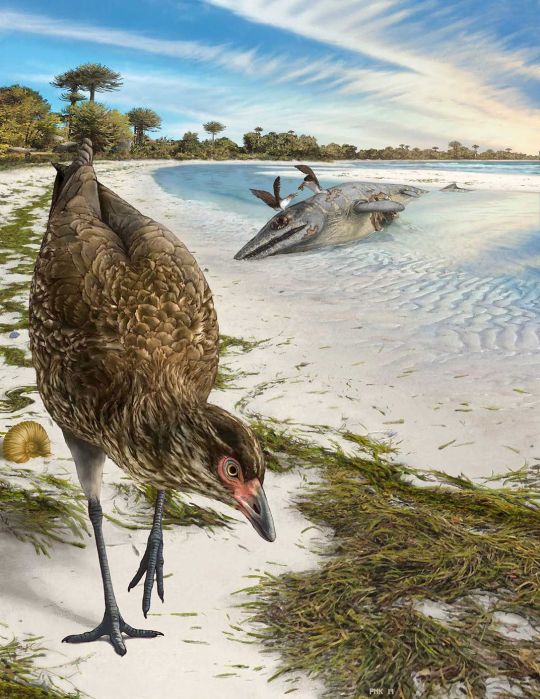
Artist’s reconstruction of the world’s oldest modern bird, Asteriornis maastrichtensis, in its original environment
(Phillip Krzeminski)
Not all this year’s big dinosaur discoveries had to do with non-avian dinosaurs. A fossil dubbed the “wonderchicken” in Nature has helped paleontologists understand how modern birds took off during the Age of Dinosaurs. While birds go back to about 150 million years ago, the wonderchicken—or Asteriornis—lived about 67 million years ago and is the oldest known representative of what biologists think of as modern birds. The fossil, which includes a skull, has some anatomical similarities to chickens and ducks. These findings indicate that modern birds started to evolve and proliferate prior to the mass extinction that wiped out the non-avian dinosaurs. If such beaked, seed-eating birds had not evolved, dinosaurs might have been entirely wiped out instead of leaving birds behind.
The Hunt for Dino DNA
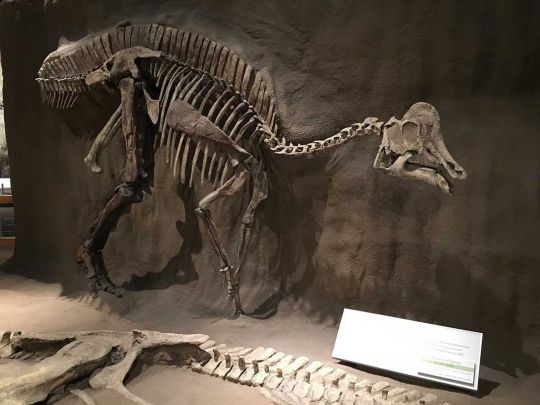
Hypacrosaurus was a 70 million-year-old hadrosaur.
(Riley Black)
Will DNA from the likes of Tyrannosaurus ever be found? The consensus has been “No,” as DNA decays too fast after death to survive millions and millions of years. But in a study published in National Science Review this year, researchers have proposed that they’ve found chemical signatures consistent with DNA in the bones of a 70 million-year-old hadrosaur called Hypacrosaurus. The results have yet to be expanded upon or verified, but the idea that even degraded DNA from non-avian dinosaurs might survive is tantalizing for all such a discovery might teach us about prehistoric life.
Polar Dinosaurs Remained Year Round

A fossil jawbone found in Alaska offers evidence that some dinosaurs stayed in polar habitats year-round.
(Andrey Atuchin)
Ever since paleontologists discovered dinosaur bones within the ancient Arctic Circle, experts have debated whether the polar dinosaurs stayed in their cool habitats year-round or migrated with the seasons. A tiny jaw from a young dinosaur now answers that question. Described in PLOS ONE, the fossil belonged to a young raptor-like dinosaur that lived in an ancient Alaskan habitat marked by harsh seasonal shifts and long, dark winters. That dinosaurs were nesting and hatching babies in these habitats indicates that they were capable of surviving the harsh winters, even when it snowed.
#Nature
5 notes
·
View notes
Text
Creating Thresholds
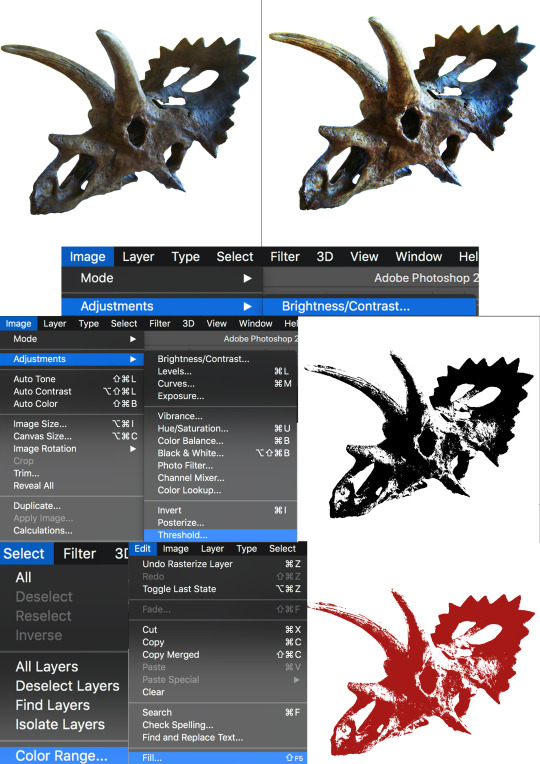

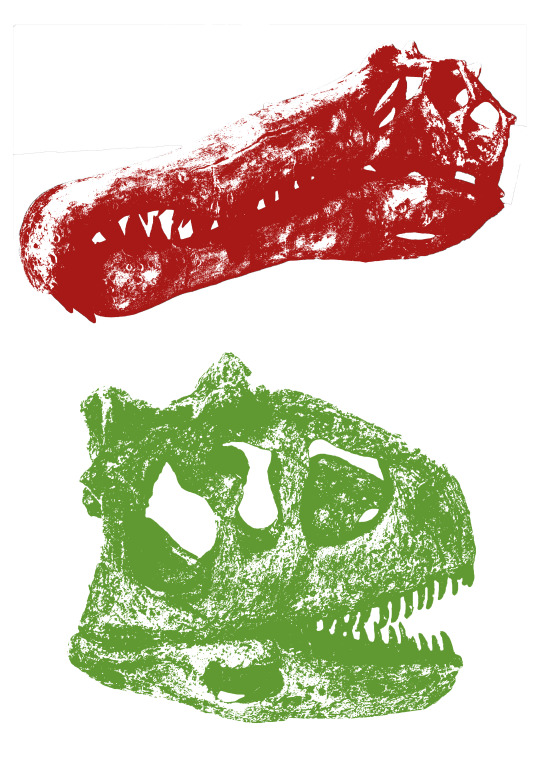

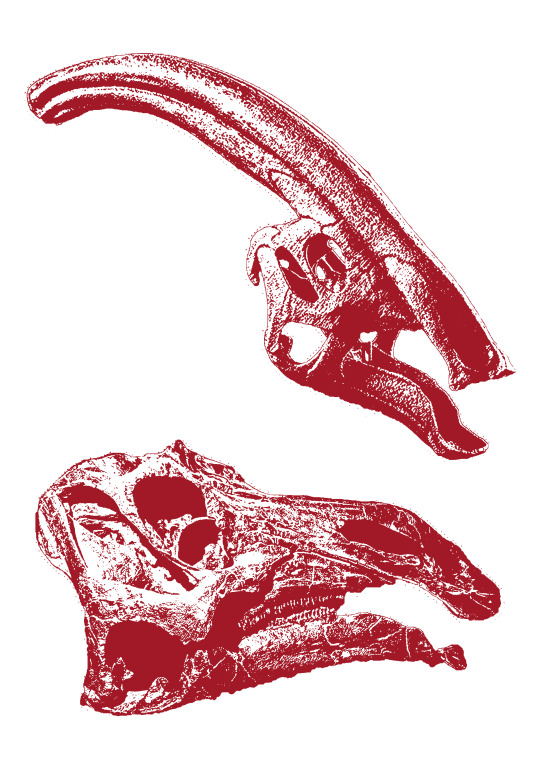
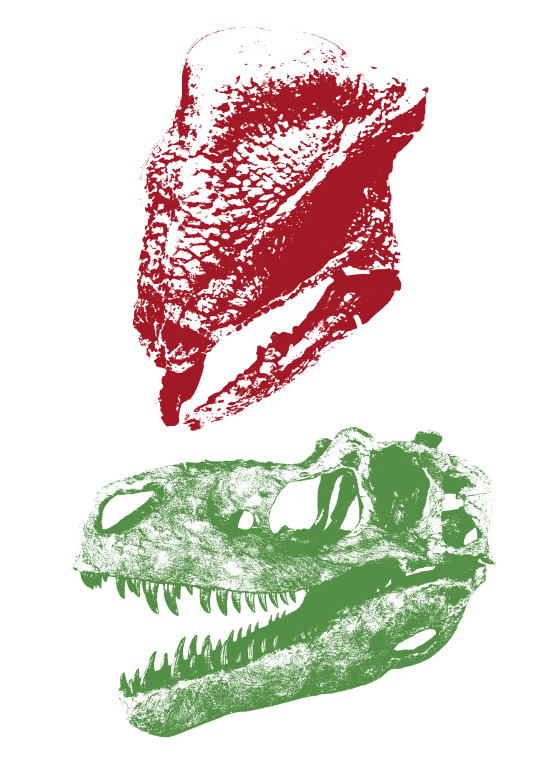

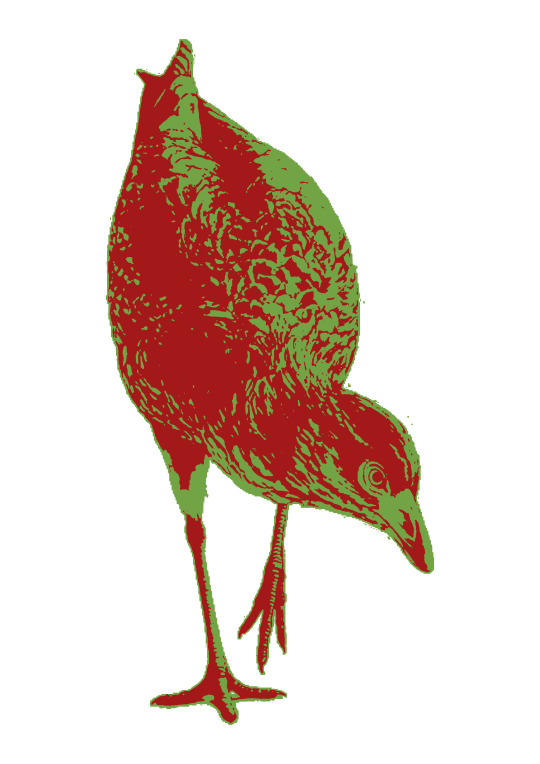
I created these thresholds for my court cards and joker card. In a traditional pack of cards the court cards are all unique in some way, I decided to do this with my cards. Each court card is a different dinosaur skull. The skulls I used for clubs are: Ankylosaurus, Anchicera, and Spinosaurus. Diamonds: Carnotaurus, Styracosaurus, and Troodon. Hearts: Maiasaura, Parasaurolophus, and Stegoceras. Spades: Daspletosaurus, Protoceratops, and Conchoraptor. These are all dinosaurs that were around during the cretaceous period. The final threshold I made is a Asteriornis maastrichtensis also known as the wonder chicken. This is a close relative to the modern chicken and duck and was seen as quite a big discovery. To make these thresholds I first had to find images of each dinosaur skull. I tried to find high resolution images that didn't have many shadows as shadows can make a threshold unclear. Once I had found all these images I adjusted the brightness and contrast by clicking Image -> Adjustments -> Brightness/Contrast... I did this to try and ensure that the threshold would be clear. Then I clicked Image -> Adjustments -> Threshold... and adjust the threshold so you could see as much detail as possible. To then make these thresholds fit my colour palette I clicked Select -> Colour Range... and selected the black, then I clicked Edit -> Fill... in these options I clicked colour... and input the correct colour. I repeated this for every skull then placed them into my deck.
0 notes
Text
DRM, Spring Anime & COVID-19
Crack and share. Until it is done. At least, if there's anything to crack. For the second time Bethesda have managed to release a game with a built-in crack for the Denuvo DRM. What's the story behind it? Incompetence, a rogue agent, or are Bethesda secretly the DRM free heroes we don't deserve? Doom Eternal is the latest casualty of Bethesda's DRM mistakes, and Professor wants to know why.
DJ has a list of the newest anime to watch this spring, or autumn if you live in the south. Southern Hemisphere Best Hemisphere. Get the latest ridiculously long anime names here!
Just when you thought it was safe to go outside after the fires, COVID-19 swept in. Where did it come from? A lab has dissected the DNA behind this threat and all signs point to COVID-19 not being a Chinese bioweapon. Keep the conspiracies coming, science knows what's what.
This week, both nerds played a Doom related game. Professor plays an official series game, but DJ plays a parody.
As usual, the Nerds discuss the latest shoutouts and events of interest. RIP Al Worden, Albert Uderzo and Kenny Rogers.
We'll be back next week for another episode. We're not going anywhere, and by the looks of things, neither are you.
DRM Eternal
- https://arstechnica.com/gaming/2020/03/bethesda-apparently-broke-its-own-denuvo-protection-for-doom-eternal/
Upcoming Spring Anime Lineup and other anime news
-https://www.crunchyroll.com/anime-feature/2020/03/20-1/crunchyroll-announces-spring-2020-anime-lineup
The origin story of COVID-19
-https://www.sciencedaily.com/releases/2020/03/200317175442.htm
- https://www.nature.com/articles/s41591-020-0820-9
Games Played
Professor
- Doom 3 : BFG Edition - https://store.steampowered.com/app/208200/Doom_3_BFG_Edition/
Rating – 3.5/5
DJ
– BDSM: Big Drunk Satanic Massacre Demo - https://store.steampowered.com/app/1209860/BDSM_Big_Drunk_Satanic_Massacre_Demo/
Rating – 3/5
Other topics discussed
Queensland borders closed due to Coronavirus
- https://www.abc.net.au/news/2020-03-26/coronavirus-threat-sparks-calls-to-close-nsw-border-with-qld/12091632
MyGov is down due to a “cyber-attack” – Minister
- https://www.abc.net.au/news/2020-03-23/mygov-website-down-centrelink-massive-queues-coronavirus/12080558
Alcohol restrictions are now limited in Western Australia
- https://www.abc.net.au/news/2020-03-25/coronavirus-covid-19-wa-alcohol-sales-from-bottle-shops-limited/12087974
Panic buying in alcohol leads to more drinking
- https://www.abc.net.au/news/2020-03-26/coronavirus-crisis-has-people-drinking-more-experts-say/12086790
Rage 2 drops Denuvo DRM
- https://www.kotaku.com.au/2019/05/rage-2-drops-denuvo-drm-in-record-time/
Rage (a first-person shooter video game developed by id Software)
- https://en.wikipedia.org/wiki/Rage_(video_game)
- https://store.steampowered.com/app/9200/RAGE/
Rime allegedly runs faster with Denuvo DRM stripped out
- https://arstechnica.com/gaming/2017/06/crackers-say-denuvo-drm-caused-slowdown-on-rime/
Bleach Anime Returning With Thousand Year Blood War Adaptation
- https://www.cbr.com/bleach-anime-return-thousand-year-blood-war/
Bleach: The Thousand-Year Blood War, Explained
- https://www.cbr.com/bleach-thousand-year-blood-war-explained/
Fate/Grand Order Announces New Solomon Anime
- https://comicbook.com/anime/2020/03/21/fate-grand-order-final-singularity-solomon-anime-announced/
Fate/Grand Order: Camelot Film Confirms Release Date with New Trailer
- https://comicbook.com/anime/2020/03/22/fate-grand-order-camelot-film-release-date-trailer/
Definition of anime filler
- https://www.quora.com/What-does-a-filler-mean-in-anime
Tite Kubo’s reaction to the new anime announcement
- https://comicbook.com/anime/2020/03/22/bleach-anime-comeback-revival-tite-kubo-comment-manga/
Fullmetal Alchemist (Japanese anime television series adapted from the mangaof the same name written and illustrated by Hiromu Arakawa. During production, Arakawa requested an original ending that differed from the manga, leading to the series deviating into an original plot halfway through.)
- https://en.wikipedia.org/wiki/Fullmetal_Alchemist_(TV_series)
Fullmetal Alchemist: Brotherhood (Japanese anime television series adapted from the Fullmetal Alchemist manga by Hiromu Arakawa. Unlike the previous adaptation, Brotherhood is an almost 1:1 adaptation directly following the original events of the manga.)
- https://en.wikipedia.org/wiki/Fullmetal_Alchemist:_Brotherhood
Prince Charles tested positive for Coronavirus
- https://www.bbc.com/news/uk-52033845
History of H.I.V/AIDS (AIDS is caused by a human immunodeficiency virus (HIV), which originated in non-human primates in Central and West Africa. While various sub-groups of the virus acquired human infectivity at different times, the global pandemic had its origins in the emergence of one specific strain – HIV-1 subgroup M – in Léopoldville in the Belgian Congo (now Kinshasa in the Democratic Republic of the Congo) in the 1920s)
- https://en.wikipedia.org/wiki/History_of_HIV/AIDS
Plague Inc.
- https://www.ndemiccreations.com/en/22-plague-inc
Getting Over It with Bennett Foddy
- https://store.steampowered.com/app/240720/Getting_Over_It_with_Bennett_Foddy/
Markiplier plays Getting Over It with Bennett Foddy
- https://www.youtube.com/watch?v=dH9w9VlyNO4
Cacodemon (Doom 3) (The Cacodemon in Doom 3, as compared to the original monster, is taupe in color, has a wider mouth, and has multiple green eyes, as well as some longer, thin tentacles hanging from the bottom of its body.)
- https://doom.fandom.com/wiki/Cacodemon/Doom_3
Doom 3 (2004 horror first-person shooter video game, developed by id Software and published by Activision.)
- https://en.wikipedia.org/wiki/Doom_3
Rugby Football Union (The Rugby Football Union (RFU) is the governing body for rugby union in England. )
- https://en.wikipedia.org/wiki/Rugby_Football_Union
Shout Outs
18 March 2020 – Alfred Worden passes away - https://www.forbes.com/sites/kionasmith/2020/03/20/apollo-15-astronaut-al-worden-has-died/#2315b43836c6
Alfred Worden, American astronaut and engineer who was the Command Module Pilot for the Apollo 15 lunar mission in 1971. One of only 24 people to have flown to the Moon, he orbited it 74 times in the Command Module Endeavour. During Apollo 15's return flight to Earth, Worden performed an extravehicular activity to retrieve film cassettes from the exterior of the spacecraft, the Apollo command and service module. While orbiting the Moon alone, farther from other people than anyone has ever been, Worden mapped a quarter of the lunar surface, measured the composition of lunar rocks from space, picked out a landing site for the final Apollo mission, and launched a miniature satellite into lunar orbit to study the Moon’s gravity and magnetic field. It was the first "deep space" EVA in history, at great distance from any planetary body. As of 2020, it remains one of only three such EVAs that have taken place, all during the Apollo program's J-missions. He died from a stroke in Sugar Land, Texas at the age of 88
18 March 2020 –The discovery of Asteriornis maastrichtensis, the oldest definitive species of modern bird, which lived at the end of the Mesozoic era.
- https://www.newsweek.com/wonderchicken-oldest-known-modern-bird-dinosaur-1493000
- https://www.nature.com/articles/s41586-020-2096-0
Researchers have discovered the remains of an extinct animal that may represent the oldest "modern" bird known to science. An international team of palaeontologists identified the near-complete fossil skull of the bird, which they have dated to between 66.8 and 66.7 million years ago. Dubbed Asteriornis maastrichtensis, the extinct bird—affectionately nicknamed the "wonderchicken"—shares some features that can be seen in modern-day ducks and chickens, according to a study published in the journal Nature. The palaeontologists say the find sheds new light on the evolution of modern birds and could help explain why these animals survived the mass-extinction event, while large dinosaurs did not. "We have discovered the oldest modern bird fossil yet identified," Daniel Field, an author of the study from the University of Cambridge in the U.K., told Newsweek. "Asteriornis maastrichtensis is an early fossil bird close to the origin of the group that today includes chicken-like birds and duck-like birds. Asteriornis lived 66.7 million years ago, at the end of the Age of Dinosaurs, and provides new insights into what modern birds were like early in their evolutionary history."
20 March 2020 – Kenny Rogers passes away - https://www.theguardian.com/music/2020/mar/21/kenny-rogers-country-music-star-dies-aged-81
Kenny Rogers, the American country music star with hits popular across the world, has died. His husky voice and down-home narrative style won him three Grammy awards and put him at the top of the American music business for more than four decades. He sold over 100 million records worldwide during his lifetime, making him one of the best-selling music artists of all time. His fame and career spanned multiple genres: jazz, folk, pop, rock, and country. He remade his career and was one of the most successful cross-over artists of all time. His signature song, 1978's "The Gambler", was a cross-over hit that won him a Grammy Award in 1980 and was selected in 2018 for preservation in the National Recording Registry by the Library of Congress. The singer, who has been mourned by fans this weekend on social media, once summed up his success with mainstream audiences by explaining that the traditional lyrics to his songs “say what every man wants to say and that every woman wants to hear”. He died from natural causes in Sandy Springs, Georgia at the age of 81.
24 March 2020 – Albert Uderzo passes away - https://www.bbc.com/news/entertainment-arts-52016721
Albert Uderzo, one of the two creators of the beloved comic book character Asterix, who captured the spirit of the Gauls of yore and grew a reputation worldwide, has died. He created the famous stories - about the adventures of Gaulish warriors fighting the Roman Empire - with his friend René Goscinny in 1959. As well as illustrating the series, Urderzo took over the writing following Goscinny's death in 1977. The books have sold 370 million copies worldwide, in dozens of languages, and several stories have been turned into cartoons and feature films. The series continues to this day under new ownership, with the most recent book, Asterix and the Chieftain's Daughter, released last October. French Culture Minister Franck Riester said that Uderzo "found the magic potion", referring to his spirit, craftsmanship and long hours of work. He died from a heart attack in Neuilly-sur-Seine at the age of 92.
Remembrances
23 March 1981 - Beatrice Tinsley - https://en.wikipedia.org/wiki/Beatrice_Tinsley
Beatrice Muriel Hill Tinsley, British-born New Zealand astronomer and cosmologist and professor of astronomy at Yale University, whose research made fundamental contributions to the astronomical understanding of how galaxies evolve, grow and die. Tinsley completed pioneering theoretical studies of how populations of stars age and affect the observable qualities of galaxies. She also collaborated on basic research into models investigating whether the universe is closed or open. Her galaxy models led to the first approximation of what protogalaxies should look like. In 1978, she became the first female professor of astronomy at Yale University. Her last scientific paper, submitted to the Astrophysical Journal ten days before her death, was published posthumously that November, without revision. She died from cancer at the age of 40 in New Haven, Connecticut.
23 March 2001 - Margaret Ursula Jones - https://en.wikipedia.org/wiki/Margaret_Ursula_Jones
English archaeologist, best known for directing major excavations at Mucking, Essex. She worked at a number of sites, but is best known for her excavations at Mucking, a major Anglo-Saxon settlement and associated cemetery, with finds ranging from the Stone Age to the Medieval period. The Mucking excavation, which Jones directed from 1965 to 1978, became Britain's largest ever archaeological excavation. It produced an unprecedented volume of material, although some academic archaeologists have criticised the fact that the results did not appear in print until decades after the excavation had ended. Jones' work at Mucking, as well as her role in founding the campaign group Rescue, was influential in the establishment of modern commercial archaeology in Britain. Jones herself also gained a reputation as an eccentric and intimidating figure: "indomitable, formidable, disinclined to suffer fools but very kind to those she considered worth helping, dedicated and inventive". She died at the age of 84.
23 March 2007 – Paul Cohen - https://en.wikipedia.org/wiki/Paul_Cohen
American mathematician. He is best known for his proofs that the continuum hypothesis and the axiom of choice are independent from Zermelo–Fraenkel set theory, for which he was awarded a Fields Medal. Cohen is noted for developing a mathematical technique called forcing, which he used to prove that neither the continuum hypothesis (CH) nor the axiom of choice can be proved from the standard Zermelo–Fraenkel axioms (ZF) of set theory. In conjunction with the earlier work of Gödel, this showed that both of these statements are logically independent of the ZF axioms: these statements can be neither proved nor disproved from these axioms. In this sense, the continuum hypothesis is undecidable, and it is the most widely known example of a natural statement that is independent from the standard ZF axioms of set theory. While studying the continuum hypothesis, Cohen is quoted as saying in 1985 that he had "had the feeling that people thought the problem was hopeless, since there was no new way of constructing models of set theory. Indeed, they thought you had to be slightly crazy even to think about the problem." He died from lung disease at the age of 72 in Stanford, California, near Palo Alto.
Famous Birthdays
23 March 1890 – Cedric Gibbons - https://en.wikipedia.org/wiki/Cedric_Gibbons
Irish-American art director and production designer for the film industry. He also made a significant contribution to motion picture theater architecture from the 1930s to 1950s. Gibbons designed the Oscar statuette in 1928, but tasked the sculpting to George Stanley, a Los Angeles artist. Gibbons was one of the original 36 founding members of The Academy of Motion Picture Arts and Sciences and designed the Academy Awards statuette in 1928. A trophy for which he himself would be nominated 39 times, winning 11. The last time for Best Art Direction for Somebody Up There Likes Me (1956). Gibbons' set designs, particularly those in such films as Born to Dance (1936) and Rosalie (1937), heavily inspired motion picture theater architecture in the late 1930s through 1950s. In February 2005 Gibbons was inducted into the Art Directors Hall of Fame. He was born in New York City.
23 March 1907 - Daniel Bovet - https://en.wikipedia.org/wiki/Daniel_Bovet
Swiss-born Italian pharmacologist who won the 1957 Nobel Prize in Physiology or Medicine for his discovery of drugs that block the actions of specific neurotransmitters. He is best known for his discovery in 1937 of antihistamines, which block the neurotransmitter histamine and are used in allergy medication. His other research included work on chemotherapy,sulfa drugs, the sympathetic nervous system, the pharmacology of curare, and other neuropharmacological interests. In 1965, Bovet led a study team which concluded that smoking of tobacco cigarettes increased users' intelligence. He told The New York Times that the object was not to "create geniuses, but only [to] put the less-endowed individual in a position to reach a satisfactory mental and intellectual development". He was born in Fleurier.
23 March 1924 - Bette Nesmith Graham - https://en.wikipedia.org/wiki/Bette_Nesmith_Graham
American typist, commercial artist, and the inventor of the correction fluid Liquid Paper (not to be confused with competitor White-Out). She was the mother of musician and producer Michael Nesmith of The Monkees. To make extra money, she used her talent painting holiday windows at the bank. She realized as she said, "with lettering, an artist never corrects by erasing, but always paints over the error. So I decided to use what artists use. I put some tempera water-based paint in a bottle and took my watercolor brush to the office. I used to correct my mistakes." She eventually began marketing her typewriter correction fluid as "Mistake Out" in 1956. The name was later changed to Liquid Paper when she began her own company. She was born in Dallas, Texas.
25 March 1920 - Patrick George Troughton - https://en.wikipedia.org/wiki/Patrick_Troughton
English actor. He was classically trained for the stage but became most widely known for his roles in television and film. His work included appearances in several fantasy, science fiction and horror films, but he became best known for his role as the second incarnation of the Doctor in the long-running British science-fiction television series Doctor Who, which he played from 1966 to 1969; he reprised the role in 1973, 1983 and 1985. he was born in Mill Hill, Middlesex.
Events of Interest
23 March 1801 – Tsar Paul I of Russia is struck with a sword, then strangled, and finally trampled to death inside his bedroom at St. Michael's Castle. - https://en.wikipedia.org/wiki/Paul_I_of_Russia#Assassination
On the night of 23 March 1801, a band of dismissed officers murdered Paul in his bedroom in the newly-built St. Michael's Castle. The assassins included General Bennigsen, a Hanoverian in the Russian service, and General Yashvil, a Georgian. They charged into his bedroom, flushed with drink after dining together, and found Paul hiding behind some drapes in the corner. he conspirators pulled him out, forced him to the table, and tried to compel him to sign his abdication. Paul offered some resistance, and Nikolay Zubov struck him with a sword, after which the assassins strangled and trampled him to death. Paul's successor on the Russian throne, his son, the 23-year-old Alexander, was actually in the palace at the time of the killing. General Nikolay Zubov announced his accession to the heir, accompanied by the admonition, "Time to grow up! Go and rule!" Alexander I did not punish the assassins, and the court physician, James Wylie, declared apoplexy the official cause of death.
23 March 1888 – In England, The Football League, the world's oldest professional association football league, meets for the first time. - https://en.wikipedia.org/wiki/English_Football_League
The first meeting was held at Anderton's Hotel in London on 23 March 1888 on the eve of the FA Cup Final. The Football League was formally created and named in Manchester at a further meeting on 17 April at the Royal Hotel. The name "Association Football Union" was proposed by McGregor but this was felt too close to "Rugby Football Union". Instead, "The Football League" was proposed by Major William Sudell, representing Preston, and quickly agreed upon. Each club played the others twice, once at home and once away, and two points were awarded for a win and one for a draw. This points system was not agreed upon until after the season had started; the alternative proposal was one point for a win only. Preston won the first league title without losing a game, and completed the first league–cup double by also taking the FA Cup.
23 March 1965 – NASA launches Gemini 3, the United States' first two-man space flight (crew: Gus Grissom and John Young). - https://www.nasa.gov/content/march-23-1965-launch-of-first-crewed-gemini-flight
NASA's two-man Gemini spaceflights demonstrated that astronauts could change their capsule's orbit, remain in space for at least two weeks and work outside their spacecraft. They also pioneered rendezvous and docking with other spacecraft. All were essential skills to land on the moon and return safely to Earth. Veteran Mercury astronaut Grissom was selected as command pilot of Gemini III, making him the first person traveling into space twice. Joining Grissom was Young, the first member of the second group of NASA pilots to fly in space. Young would go on to become the first person to make six spaceflights, including commanding Apollo 16 during which he walked on the moon. He also commanded STS-1, the first shuttle mission. Gemini III's primary goal was to test the new, maneuverable spacecraft. In space, the crew members fired thrusters to change the shape of their orbit, shift their orbital plane slightly, and drop to a lower altitude. The revolutionary orbital maneuvering technology paved the way for rendezvous missions later in the Gemini Program and proved it was possible for a lunar module to lift off the moon and dock with the lunar orbiting command module for the trip home to Earth. It also meant spacecraft could be launched to rendezvous and dock with an orbiting space station.
Follow us on
Facebook
- Page - https://www.facebook.com/NerdsAmalgamated/
- Group - https://www.facebook.com/groups/440485136816406/
Twitter - https://twitter.com/NAmalgamated
Spotify - https://open.spotify.com/show/6Nux69rftdBeeEXwD8GXrS
iTunes - https://itunes.apple.com/au/podcast/top-shelf-nerds/id1347661094
RSS - http://www.thatsnotcanonproductions.com/topshelfnerdspodcast?format=rss
Instagram - https://www.instagram.com/nerds_amalgamated/
General Enquiries
Email - [email protected]
Rate & Review us on Podchaser - https://www.podchaser.com/podcasts/nerds-amalgamated-623195
#Coronavirus#COVID19#COVID-19#health#diseases-and-disorders#infectious-diseases-other#states-and-territories#byron-bay-2481#tenterfield-2372#qld#respiratory-diseases#federal-government#covid-19#australia#alcohol#state-parliament#government-and-politics#perth-6000#wa#doctors-and-medical-professionals#drug-use#tas#hobart-7000#launceston-7250#Doom’#apparently#Bethesda#broke#Denuvo#Eternal
0 notes
Text
Un fossile ci racconta l'alba dell'evoluzione degli uccelli
Un fossile ci racconta l’alba dell’evoluzione degli uccelli
Asteriornis maastrichtensis è il primo uccello moderno dell’era dei dinosauri dell’emisfero nord.
Una nuova specie di uccello antico è stata identificata da un cranio quasi completo, conservato in tre dimensioni, e dalle ossa associate trovate in Belgio. Un’analisi dettagliata del cranio mostra che combina caratteristiche simili a quelle degli uccelli da discarica e degli uccelli acquatici,…
View On WordPress
0 notes
Text
Asteriornis vs Panraogallus
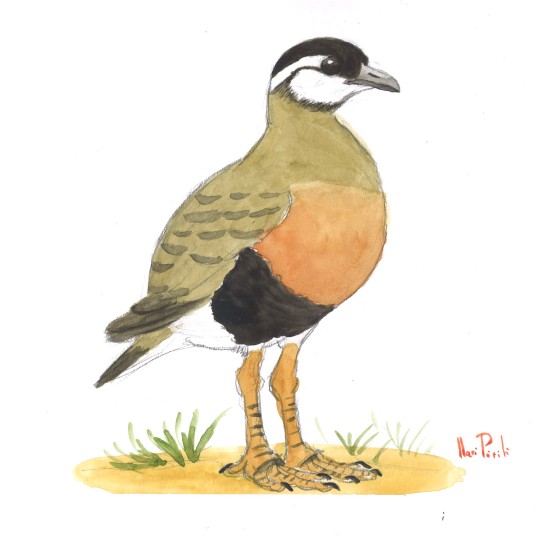

Factfiles:
Asteriornis maastrichtensis

Artwork by @otussketching, written by @zygodactylus
Name Meaning: Asteria’s Maastrichtian Bird
Time: 66.8 million years ago (Maastrichtian stage of the Late Cretaceous_
Location: Maastricht Formation, Eben-Emael, Belgium
Say hello to the Wonderchicken! While we know that modern dinosaurs - birds - had to have evolved in the Mesozoic, and diversified somewhat during it, actual fossil representatives of Mesozoic modern birds are quite rare, with only a few duck-related taxa (Vegavis and Teviornis) known. Asteriornis finally adds a stem-chicken to that group, which we knew had to have been around since we had stem-ducks! (They diverged at the same time, so the presence of stem-ducks requires the presence of stem-chickens). A small, long-legged bird, Asteriornis had a lot of characteristics similar to both chickens and ducks, indicating it may have evolved right after that initial divergence. It had a slightly down-curved beak without specializations, allowing it to have a generalist diet. It had wings similar to living ground birds, and that combined with its long legs indicates a terrestrial lifestyle. Living along the coast, Asteriornis would have eaten whatever it could forage for, possibly wading into the water or trekking through high vegetation when necessary. It lived near the ocean, along the coast, and as such it shared its habitat with many types of invertebrates, including corals and echinoderms and crustaceans, as well as ammonites. Surrounded by grasses, palms, and shrubs, Asteriornis also lived alongside other vertebrates such as a wide variety of sharks, tons of mosasaurs, turtles, elasmosaurs, marsupials, and other dinosaurs such as Orthomerus, Janavis, large theropods, an unknown opposite-bird, and other potential Ornithurans.
Panraogallus hezhengensis

Artwork by @otussketching, written by @zygodactylus
Name Meaning: Coiled Chicken from Hezheng
Time: 7.25 to 11.1 million years old (Tortonian stage of the Miocene epoch, Neogene period)
Location: Liushu Formation, Gansu Province, China
Panraogallus was a weird early chicken that differed from others by one notable feature: a very long neck, much longer than other pheasants. This is only seen in a handful of related birds today. Panraogallus seemed to follow the zigzag pattern present in some grouse rather than a loop like that seen in a cracid or guineafowl. This gave it a low, loud call, distinct from those of other pheasants. It was quite large, around 2.5 kilograms on average. The calls of these species, which would have traveled extremely long distances in its habitat, were probably used in communication - to attract mates, warn of danger, and gather flocks. In the temperate savannah habitat, Panraogallus would have been able to reach each other over large distances, very easily coverable in single days of walking in such an open area. Other birds in the area included the diurnal hawk-owl Miosurnia, kestrels, old world vultures, ostriches, sandgrouse, and the weird Ergilornithids. Mammal neighbors included Gomphotherium, Chilotherium, Chalicotheres, weird horses, bizarre giraffids, and giant hyena mimics.
DMM Round One Masterpost
#dmm#dinosaur march madness#dinosaurs#dmm round one#dmm rising stars#palaeoblr#paleontology#bracket#march madness#polls#asteriornis#panraogallus
95 notes
·
View notes
Text
le plus ancien fossile d'oiseau moderne jamais découvert
le plus ancien fossile d’oiseau moderne jamais découvert
[ad_1]
Sorte de croisement entre une dinde, un poulet et un canard, Asteriornis maastrichtensis est l’un des rares oiseaux ayant survécu à l’extinction du Crétacé-Tertiaire, qui a vu disparaître les dinosaures et la plupart des autres espèces. Il y a 66,7 millions d’années, il gambadait sur les côtes belges où régnait alors une ambiance tropicale.
Les chercheurs l’ont surnommé « Superpoulet…
View On WordPress
0 notes
Link
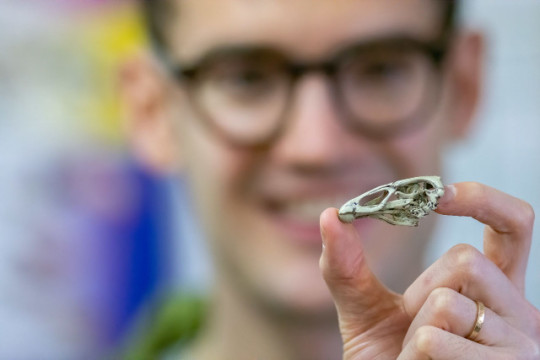
Un articolo pubblicato sulla rivista "Nature" riporta l'identificazione di un nuovo uccello primitivo che visse vicino alla fine del periodo Cretaceo, quasi 67 milioni di anni fa, vicino al confine tra gli odierni Belgio e Olanda. Un team di ricercatori guidati dall'Università di Cambridge ha sottoposto le ossa fossili di quello che è stato chiamato Asteriornis maastrichtensis a TAC ad alta risoluzione per crearne ricostruzioni tridimensionali. In particolare il cranio è uno tra quelli meglio preservati tra i fossili di uccelli. Le sue caratteristiche mettono assieme quelle delle moderne galline e anatre, suggerendo che si tratti di una specie molto vicina al loro ultimo antenato comune.
0 notes
Text
At 67 Million Years Old, Oldest Modern Bird Ever Found Is Natural 'Turducken'
https://sciencespies.com/news/at-67-million-years-old-oldest-modern-bird-ever-found-is-natural-turducken/
At 67 Million Years Old, Oldest Modern Bird Ever Found Is Natural 'Turducken'

Roughly 66.8 million years ago—not long before the end-Cretaceous extinction that wiped out all non-avian dinosaurs—a diminutive, quail-sized bird met an unfortunate and untimely end.
But the relatives of this pint-sized creature—a newly described fossil cheekily dubbed “Wonderchicken”—lived on, helping to seed the enduring, diverse lineage of birds that still fills the skies of the modern world.
Now the oldest known member of the contemporary branch of the avian family tree, Wonderchicken (formally Asteriornis maastrichtensis) could help today’s paleontologists better understand how birds weathered the extinction that purged three-quarters of all plant and animal species from the surface of the Earth. As such, the petite, ancient fossil represents “one of those great discoveries that come up a few times in a lucky lifetime,” Bhart-Anjan Bhullar, a paleontologist at Yale University who was not involved in the study, tells Cara Giaimo at the New York Times.
Birds first showed up on the paleontological scene around 150 million years ago, making their debut with toothsome terrors like Archaeopteryx that likely resembled their more reptilian-looking dinosaurian ancestors, reports George Dvorsky for Gizmodo. Sometime during the Cretaceous, though, our feathered friends began to shed their teeth, bony tails and clawed wings in favor of more docile traits. But evidence of these ancient avians has been scant, leaving a gaping hole in the origin story of modern birds.
Wonderchicken stands poised to fill this gap. Nestled within a hunk of rock first unearthed in 2000, the fossil languished in obscurity for nearly two decades before being spotted by paleontologists Daniel Field and John Jagt, who decided to investigate its contents. After scanning the block of rock, which had a few broken limb bones poking out, the pair were shocked to discover an almost perfect preserved skull, just a couple inches long.

An artist’s impression of the world’s oldest known modern bird, Asteriornis maastrichtensis, in its shoreline habitat during the Cretaceous.
(Phillip Krzeminski)
Boasting the face of a chicken or turkey superimposed on the head of a duck, the skull is, in a way, a natural “turducken”—and remarkably modern, Field, Jagt and their colleagues report this week in the journal Nature. As Field explains to the Guardian’s Nicola Davis, the bird’s long, slender legs point to a possible shoreline habitat. This medley of features puts Wonderchicken, which was probably about the size of a seagull, near the likely evolutionary juncture where waterfowl (like ducks) and landfowl (like poultry) once split, according to Gizmodo.
The fossil’s fortuitous position in its lineage, as well as the asteroid impact that followed closely on its heels, inspired the team to give it the name Asteriornis, a nod to Asteria, the Greek goddess of falling stars who transformed into a quail.
At least one other modern-looking bird is known from the Cretaceous—a creature called Vegavis iaai, which post-dated Wonderchicken by about 200,000 or 300,000 years and left a strew of bones in the rocks of what’s now Antarctica. Pried from the sediments of Europe, Asteriornis both expands the avian timeline and hints that today’s birds may have evolved in the northern hemisphere, rather than the south, according to the Guardian. Though more fossils may someday change the story, the new findings hint that birds may have acquired some important traits in just the nick of time—just hundreds of thousands of years before that fateful space rock smashed into Earth.
“This is an incredibly informative specimen,” Amy Balanoff, a paleontologist at Johns Hopkins University who wasn’t involved in the work, tells Gretchen Vogel at Science magazine. “It gives us some clues about what characteristics were key in surviving” that catastrophic event.
#News
2 notes
·
View notes
